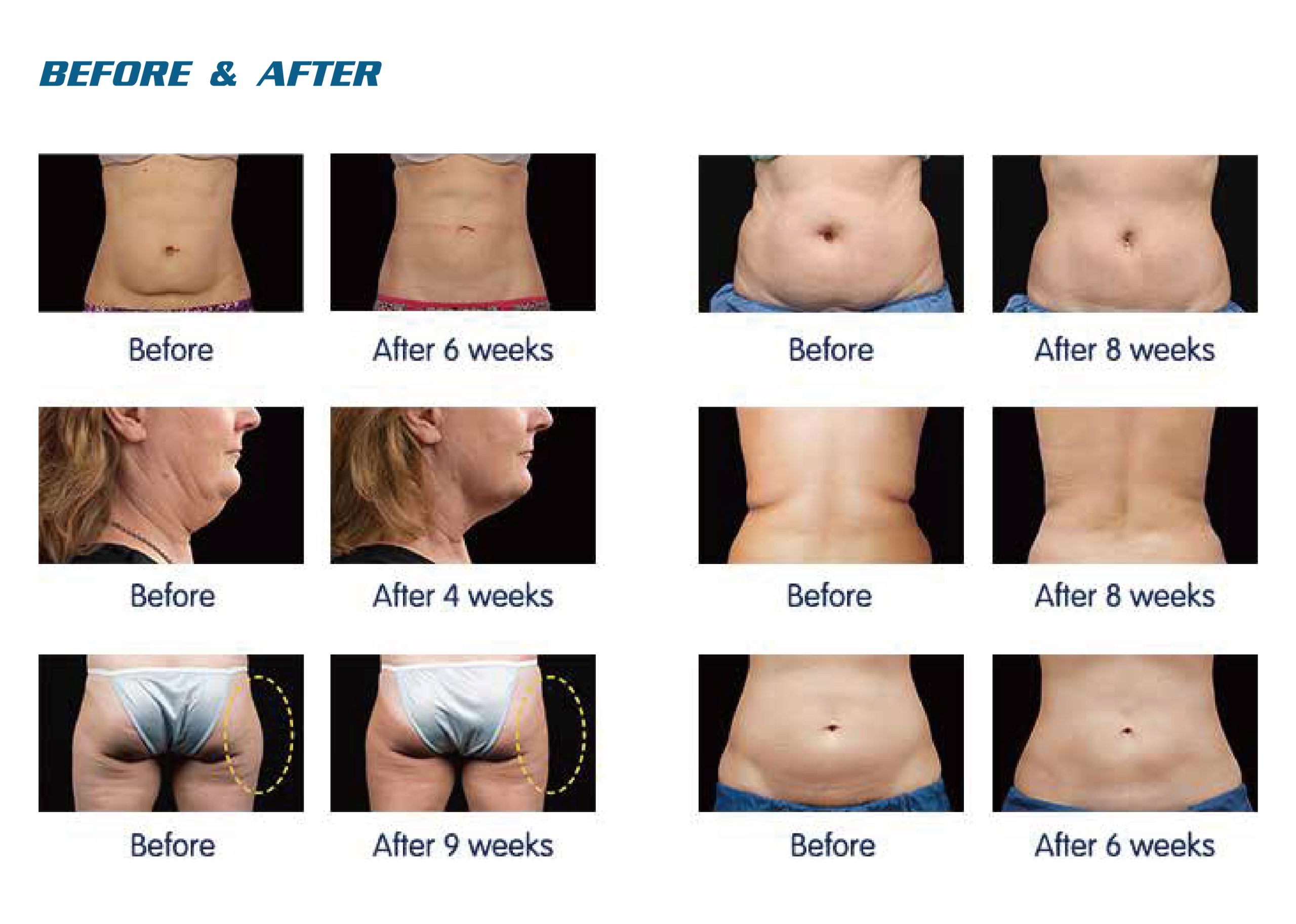Understanding Cryolipolysis and Its Effects
Cryolipolysis, commonly known as CoolSculpting, is a non-invasive fat reduction procedure that has gained popularity in recent years. The science behind cryolipolysis involves the targeted application of cold temperatures to induce the death of fat cells. This innovative technique was developed by Harvard scientists who observed the phenomenon of fat reduction in children’s cheeks after sucking on popsicles. The exposure to cold temperatures led to the formation of dimples, prompting further investigation into the potential for fat reduction through controlled cooling.
According to a review published in the journal “Lasers in Surgery and Medicine,” it is believed that a few days after cryolipolysis treatment, the cooled fat cells undergo apoptosis, or cell death. Over the following months, macrophages, which are part of the body’s immune system, play a crucial role in digesting these dead fat cells. This process ultimately results in a reduction of localized fat deposits without causing harm to surrounding tissues.
The expected outcomes of cryolipolysis treatments are notable, with an average reduction in fat ranging from about 10% to 25% per round of treatment. Clinical data indicates that results can be visible as soon as three weeks post-treatment, with maximum benefits typically observed at approximately three months. These findings provide reassurance to individuals seeking effective non-surgical solutions for targeted fat reduction.
A study conducted by Dierickx et al. in 2013 examined the safety and incidence of complications following cryolipolysis. The research revealed that out of 850,000 procedures performed worldwide, only 850 adverse events were reported. Moreover, there were no persistent ulcerations, scarring, or infections associated with the treatment. These findings underscore the safety and efficacy of cryolipolysis as a viable option for individuals looking to address localized areas of concern without invasive procedures.
In addition to its effectiveness and safety profile, cryolipolysis offers minimal downtime compared to traditional surgical interventions such as liposuction. This makes it an attractive option for individuals seeking non-invasive alternatives for body contouring and sculpting.
Overall, understanding the science behind cryolipolysis and its effects provides valuable insights into its mechanism of action and expected outcomes for individuals considering this innovative approach to fat reduction.
Expected Outcomes and Recovery Timeline
The recovery timeline post-cryolipolysis treatment is an essential aspect for individuals undergoing this procedure. Results can be seen within three weeks following treatment initiation, with maximum benefits typically realized at approximately three months post-treatment. This gradual progression allows for natural adjustments within the body as it responds to the targeted fat reduction process induced by cryolipolysis.
Stay tuned for more information on managing extreme temperatures post-crylipolyis treatment.
What Not to Do After Cryolipolysis?
After undergoing cryolipolysis, it is crucial to be mindful of certain practices to ensure a smooth recovery and optimal results. Avoiding High Temperatures and Avoiding Cold Extremes are essential considerations post-treatment.
Avoiding High Temperatures
The Risks of Heat Exposure
Exposing the treated area to high temperatures immediately after cryolipolysis can compromise the effectiveness of the treatment and potentially lead to adverse effects. High temperatures may interfere with the body’s natural response to the cooling process, hindering the targeted breakdown of fat cells. Additionally, heat exposure can exacerbate post-treatment side effects such as redness, swelling, and discomfort, prolonging the recovery period.
Activities to Avoid
Following cryolipolysis, individuals should refrain from activities that induce excessive heat buildup in the body. This includes but is not limited to:
- Prolonged sun exposure
- Hot baths or saunas
- Intense physical exercise leading to profuse sweating
It is important for individuals to prioritize a cool and comfortable environment for the treated areas in order to support the body’s natural healing process.
Avoiding Cold Extremes
Why Cold Can Be Harmful
While cryolipolysis involves controlled cooling of targeted areas, exposing these areas to extreme cold immediately after treatment can have detrimental effects on skin health and overall recovery. Extreme cold temperatures can disrupt blood flow and potentially cause tissue damage, counteracting the intended benefits of cryolipolysis.
Safe Practices in Cold Environments
In colder climates or during winter months, it is advisable for individuals who have undergone cryolipolysis to take precautionary measures when exposed to cold environments. This may include:
- Dressing warmly with appropriate layers
- Using protective clothing such as gloves and hats
- Limiting prolonged exposure to freezing temperatures
By being mindful of temperature extremes and taking proactive steps to avoid both high heat and extreme cold following cryolipolysis, individuals can support their body’s healing process and optimize the outcomes of their treatment.
Managing Temperature Extremes Post-Treatment
After undergoing cryolipolysis, it is crucial for individuals to create an environment conducive to optimal recovery by managing temperature extremes. This includes considerations for ideal temperature conditions, home environment settings, clothing and fabric choices, as well as adjustments to activities and lifestyle practices.
Ideal Temperature Conditions for Recovery
Creating a suitable home environment post-cryolipolysis treatment is essential for supporting the body’s natural healing process. Maintaining a cool and comfortable setting can aid in minimizing discomfort and promoting effective recovery.
Home Environment Settings
Individuals are advised to set their indoor thermostat to a moderate temperature, ensuring that the treated areas are not exposed to excessive heat or cold. By maintaining a comfortable indoor climate, the body can focus on healing without being subjected to temperature extremes that may interfere with the fat reduction process initiated by cryolipolysis.
Clothing and Fabric Choices
Choosing appropriate clothing and fabrics can contribute to creating an ideal temperature environment for recovery. Loose-fitting, breathable garments made from natural fibers such as cotton can help regulate body temperature and prevent overheating of the treated areas. Additionally, wearing soft fabrics that do not irritate the skin is recommended to promote comfort during the recovery period.
Activities and Lifestyle Adjustments
In addition to environmental considerations, making adjustments to daily activities and lifestyle practices can further support the recovery process post-cryolipolysis treatment.
Safe Exercise Practices
Engaging in light physical activities such as gentle walking or low-impact exercises is encouraged after cryolipolysis. It is important for individuals to avoid strenuous workouts that may lead to excessive sweating or increased body temperature in the treated areas. By incorporating safe exercise practices, individuals can maintain their overall well-being while allowing their bodies to heal effectively.
Dietary Considerations for Optimal Healing
Nutrition plays a crucial role in promoting optimal healing post-cryolipolysis treatment. Consuming a balanced diet rich in nutrient-dense foods supports the body’s natural healing processes and aids in achieving favorable outcomes. Emphasizing hydration and incorporating foods with anti-inflammatory properties can further contribute to a smooth recovery journey.
By prioritizing ideal temperature conditions within the home environment, making mindful choices regarding clothing and fabric selections, as well as implementing safe exercise practices and dietary considerations, individuals can actively participate in their recovery journey following cryolipolysis treatment.
Practical Tips for a Smooth Recovery
Monitoring and Managing Skin Health
After undergoing cryolipolysis, it is essential to monitor and manage skin health to ensure a smooth recovery process. By being attentive to signs of proper healing and knowing when to seek medical advice, individuals can actively participate in their post-treatment care.
Signs of Proper Healing
Proper healing following cryolipolysis treatment involves observing the gradual changes in the treated areas as the body responds to the fat reduction process. Some indications of effective healing include a reduction in localized swelling, diminished tenderness, and a subtle improvement in the contours of the treated areas. Additionally, individuals may notice a gradual decrease in the appearance of targeted fat deposits over time, signaling successful outcomes from the procedure.
It is important for individuals to maintain regular communication with their healthcare providers to discuss any concerns or observations related to their recovery progress. This proactive approach allows for timely guidance and support throughout the healing journey.
When to Seek Medical Advice
While most individuals experience a smooth recovery following cryolipolysis, there are instances where seeking medical advice is warranted. If individuals encounter prolonged discomfort, persistent redness or swelling, or any unexpected changes in the treated areas, it is advisable to consult with a healthcare professional. Prompt medical attention can address any potential issues and ensure that individuals receive appropriate care tailored to their specific needs.
By staying vigilant about skin health and recognizing signs of proper healing while remaining attentive to any developments that may require medical attention, individuals can navigate their recovery journey with confidence and peace of mind.
Long-term Care and Maintenance
Sustaining results safely and considering future treatments and precautions are integral aspects of long-term care following cryolipolysis. Emphasizing healthy lifestyle choices and understanding the potential for additional treatments contribute to maintaining favorable outcomes over time.
Sustaining Results Safely
Incorporating healthy lifestyle practices such as regular physical activity and balanced nutrition plays a significant role in sustaining results achieved through cryolipolysis. Individuals who prioritize healthy habits are more likely to maintain their desired body contours while promoting overall well-being. Furthermore, maintaining hydration levels and minimizing excessive calorie intake supports the body’s natural processes for long-term success post-treatment.
Future Treatments and Precautions
For some individuals, achieving optimal results may involve multiple treatments over time. Understanding that multiple sessions may be necessary for reaching desired outcomes aligns with expert insights on maximizing the benefits of cryolipolysis. It is important for individuals to approach future treatments with realistic expectations while acknowledging that gradual improvements often necessitate ongoing commitment.
Moreover, taking precautions such as protecting treated areas from extreme temperatures and prioritizing skin health contribute to optimizing the effectiveness of subsequent treatments. By adhering to these considerations, individuals can proactively engage in long-term care strategies that align with their aesthetic goals.
Incorporating practical tips for monitoring skin health, recognizing signs of proper healing, knowing when to seek medical advice, sustaining results safely through healthy lifestyle choices, understanding future treatment considerations, and taking necessary precautions empowers individuals with comprehensive guidance for a smooth recovery journey post-cryolipolysis treatment.
Nubway
Nubway‘s Cryolipolysis treatment is a state-of-the-art, non-invasive fat reduction procedure that employs controlled cooling to eliminate stubborn fat cells that are resistant to diet and exercise. This pioneering technology is designed to target and freeze fat cells beneath the skin without affecting the skin’s surface, leading to a natural reduction of fat cells in treated areas.
Nubway‘s Cryolipolysis is a safe and effective alternative to traditional liposuction, offering significant results with minimal downtime. The procedure is relatively quick, typically lasting between 35 to 60 minutes per treatment area, and results can be seen as early as three weeks, with the most dramatic results visible after two months.
The Nubway Cryolipolysis system is renowned for its precision and customization capabilities. It allows practitioners to adjust the cooling intensity to cater to individual fat reduction needs. This personalized approach ensures optimal results and patient satisfaction.
In terms of managing extreme temperatures after treatment, Nubway’s Cryolipolysis is designed to minimize discomfort. The cooling process gradually lowers the temperature of the targeted fat cells, reducing the risk of thermal shock. However, patients may experience a temporary sensation of cold or numbness in the treated area.
In conclusion, Nubway’s Cryolipolysis is a groundbreaking solution for those seeking a non-invasive, effective, and long-lasting fat reduction treatment. It offers a unique blend of safety, precision, and customization, making it a preferred choice for both practitioners and patients alike. This treatment is a testament to Nubway’s commitment to providing advanced, patient-friendly solutions for body contouring and fat reduction.
Final Thoughts
Emphasizing Patient Education and Safety
Prioritizing patient education and safety is paramount in the context of cryolipolysis treatment. By equipping individuals with comprehensive information about the procedure, expected outcomes, and post-treatment care, healthcare providers can empower patients to make informed decisions and actively participate in their recovery journey.
Expert Panel Insights: During interviews with expert panelists, consensus was reached on guidelines and recommendations related to patient satisfaction, treatment outcomes, and adverse events. This underscores the significance of integrating expert insights into patient education initiatives to ensure a thorough understanding of treatment expectations and potential considerations.
Educating patients about the science behind cryolipolysis, including its mechanism of action and anticipated results, fosters transparency and cultivates trust between healthcare providers and individuals seeking this non-invasive fat reduction approach. Furthermore, emphasizing the importance of adhering to post-treatment guidelines, such as managing temperature extremes and adopting healthy lifestyle practices, contributes to optimizing treatment outcomes while promoting patient safety.
Incorporating educational resources such as informational brochures, digital content, or one-on-one consultations enables patients to gain a comprehensive understanding of cryolipolysis and its implications for their unique circumstances. By addressing common queries related to recovery expectations, potential side effects, and long-term care considerations, healthcare providers can instill confidence in patients throughout their treatment experience.
Encouraging Professional Consultation for Concerns
Encouraging open communication and professional consultation for any concerns or uncertainties is pivotal in ensuring that individuals feel supported before, during, and after cryolipolysis treatment. Establishing a collaborative environment where patients feel comfortable expressing their questions or apprehensions fosters a sense of partnership between healthcare providers and those undergoing the procedure.
By fostering an environment where individuals feel encouraged to seek professional guidance for any post-treatment issues or inquiries, healthcare providers can effectively mitigate potential concerns while offering tailored support based on individual needs.
In conclusion, prioritizing patient education through evidence-based insights from expert panelists and encouraging open dialogue for professional consultation underscores the commitment to delivering safe and informed care within the realm of cryolipolysis treatments. By upholding these principles, healthcare providers can uphold high standards of patient-centered care while promoting positive treatment experiences for individuals seeking non-invasive fat reduction solutions.







